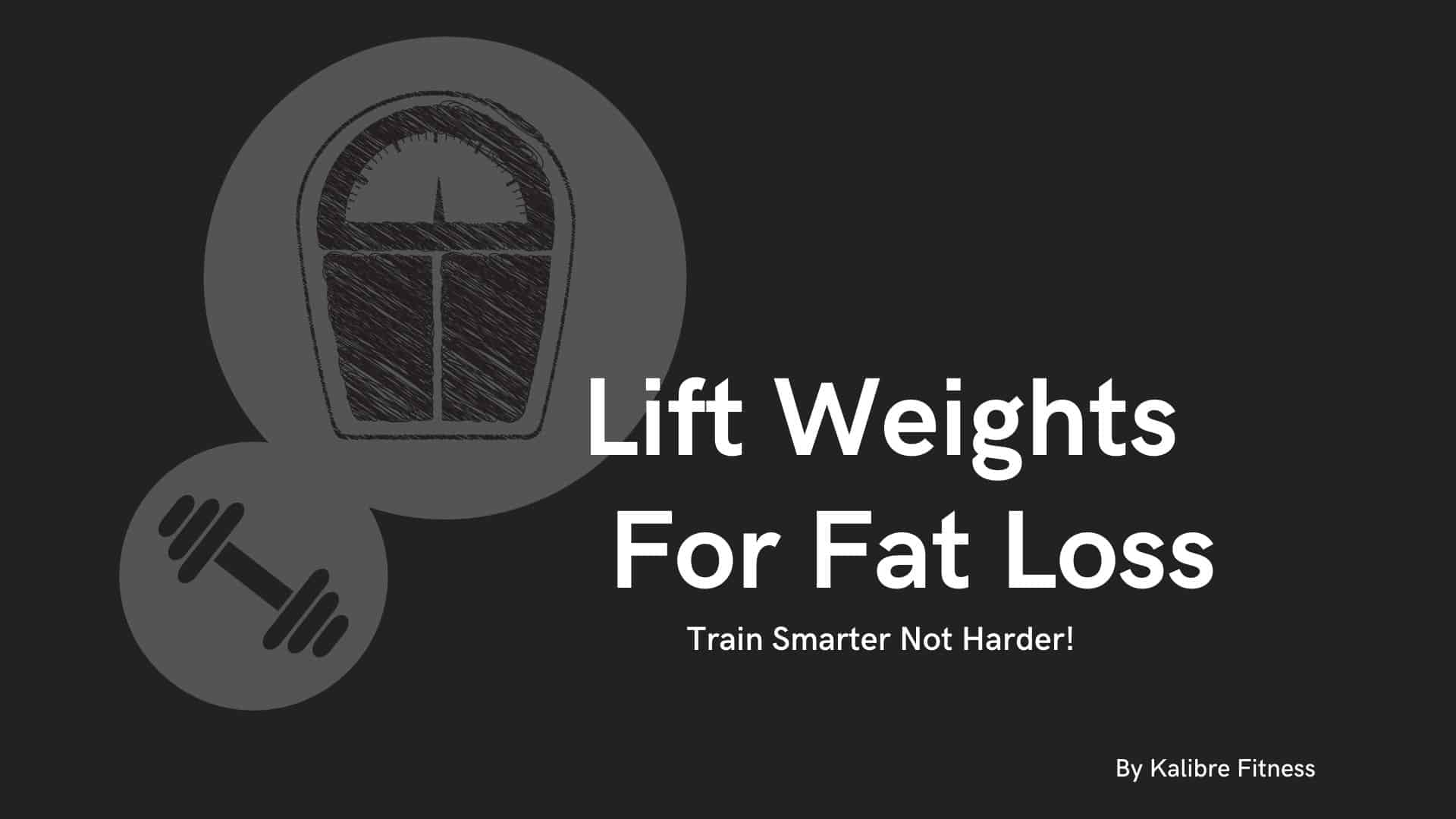Today’s post will definitively explain the reason why EVERYONE should lift weights to lose fat.
I’m Kal, and I have been weightlifting, gaining muscle, and losing fat for 12 years now.
I’m not quite a fitness professional. But 12 years of trial and error, and trawling the internet for health and fitness information makes me pretty knowledgeable on the subject.
I have achieved my desired physique. And now I want to help YOU achieve YOURS!
This post will explain why weightlifting will give you superior fat loss results, and how to begin your weightlifting program today!
Sound good? Let’s jump right in!
- What Is Resistance Training?
- Fat Loss By “Afterburn”
- Why Does Afterburn Happen?
- Cardio vs Weight Training (Weight Lifting Reigns Supreme)
- Why Is Weight Lifting The Industry Favourite?
- 6 Other Benefits Of Weight Lifting
- How To Start Weightlifting Today
- Weight Lifting – Where To Start
- 1. Equipment Type
- 2. Exercise Type
- 3. Training Style
- Training Days & Duration Of Workout
- Training Style
- Progressive Overload Training
- Time Under Tension Training
- Conclusion
What Is Resistance Training?
Resistance training, or “strength training” is an umbrella term for many exercises that move the body against an opposing force.
Ways To Apply Resistance
1) Free Weights.
2) Weight Machines.
3) Resistance Bands.
4) Body Weight.
Therefore weight lifting (free weights and weight machines) is a specific type of resistance training.
A resistance training program will improve both muscular strength and endurance (1). These are two aspects of fitness that will help you burn calories more quickly (we will find out why later!)
There are many ways to lose fat. So why should you do resistance training?
Fat Loss By “Afterburn”
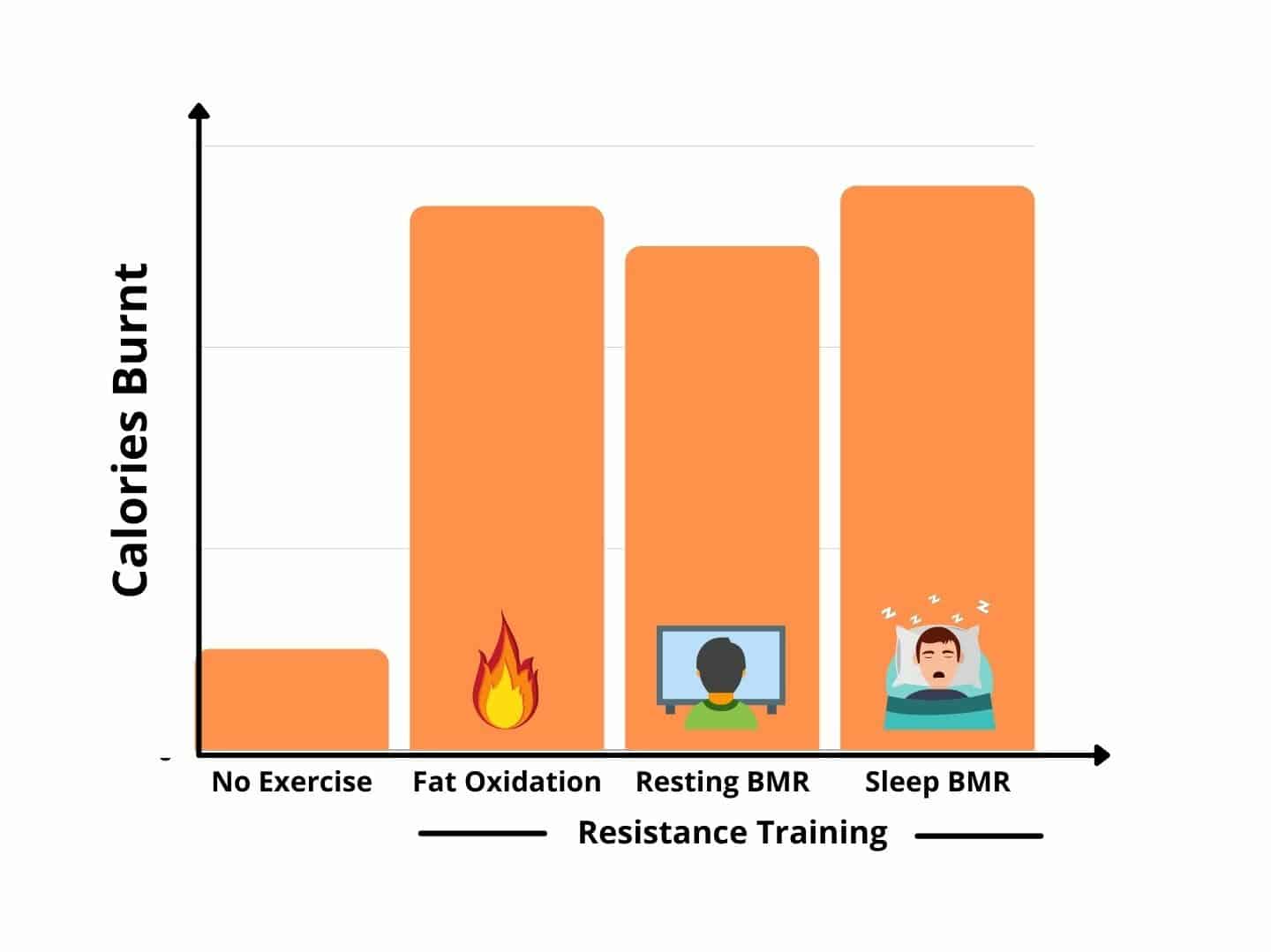
Resistance training results in unique fat-burning properties in the body. Not only does resistance training burn calories during a workout, but it will also burn fat after a workout!
Here’s an interesting study(2):
Case Study
A group of men undertook a 6 month resistance training programme. The exercise programme involved performing an 11-minute workout just three times a week.
This resulted in:
1) Increased fat oxidation.
2)Increased resting metabolic rate.
3) Increased sleeping metabolic rate.
The continual fat-burning property is due to a process called Excess Post-Exercise Oxygen Consumption (EPOC).
EPOC is more commonly known as “Afterburn”, and it can last up to 48 hours. (3)(4)
Afterburn burns fat even after you go to sleep!
Why Does Afterburn Happen?
Have you ever wondered why you can’t sprint for long periods of time?
This is because sprinting is an explosive movement.
The muscles burn ENORMOUS amounts of energy in a short period of time. This evolutionary mechanism allowed our caveman ancestors to quickly run away from a saber tooth tiger.
But where does the energy come from?
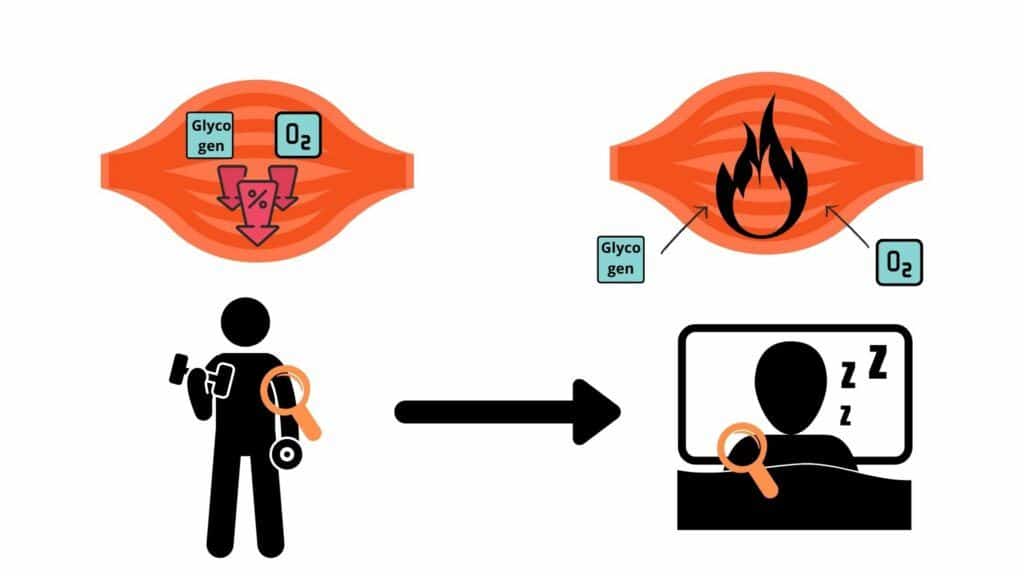
At rest, your muscles contain their own reserve nutrients, such as glycogen (stored carbohydrates) and oxygen. This reserve allows emergency access to large amounts of energy when required.
Handy as the nutrient reserve is, it’s also in limited supply. Once the reserve runs out, it needs to be slowly replenished before being used again.
The requirement for steady nutrient replenishment after explosive movement means you cannot sprint indefinitely.
It’s also the reason why afterburn occurs (the body is slowly replacing the energy reserve lost during resistance training). (5)
Afterburn is unique to resistance training and does not occur with low-intensity steady-state cardio (like jogging).
This is because low-intensity exercises do not tap into the muscle energy reserves. Instead, nutrients are supplied slowly by the blood.
All forms of resistance training can be great fat burners, but today we will focus on weight training.
Cardio vs Weight Training (Weight Lifting Reigns Supreme)
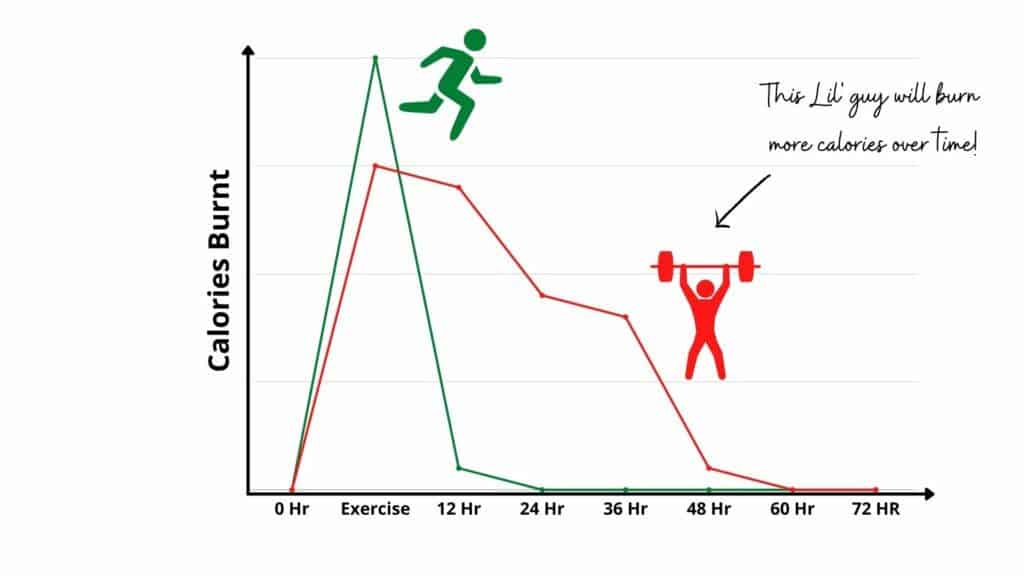
Weight training is an excellent form of resistance training to lose fat.
A typical weightlifting workout will burn between 90-230+ calories in 30 minutes. The exact calories burnt will depend on factors such as gender, body composition, height, weight, age, training intensity, and weight load. (6)(7)
Although steady-state cardio burns slightly more calories during the workout, weightlifting CONTINUES to burn significant calories even after a workout.
This is because of the afterburn effect described above.(8)
Why Is Weight Lifting The Industry Favourite?

Did you know most personal trainers will engage their clients in weightlifting?
Regardless of whether the goal is to strip pounds or gain bulk, a weight-lifting regime will invariably crop up in a personal training program.
Why is this?
Hint: they aren’t just being lazy with a “one size fits all” attitude!
It’s because weight training will burn superior calories in the shortest duration of time spent working out!(26)
Many people cannot afford to spend hours every day running. But weight training will allow you to burn calories during AND after a workout (through the afterburn effect). Work smarter, not harder!
Do you need more convincing?
Here are l 6 bonus benefits of weightlifting.
6 Other Benefits Of Weight Lifting
1. Build Muscle Whilst Losing Fat.
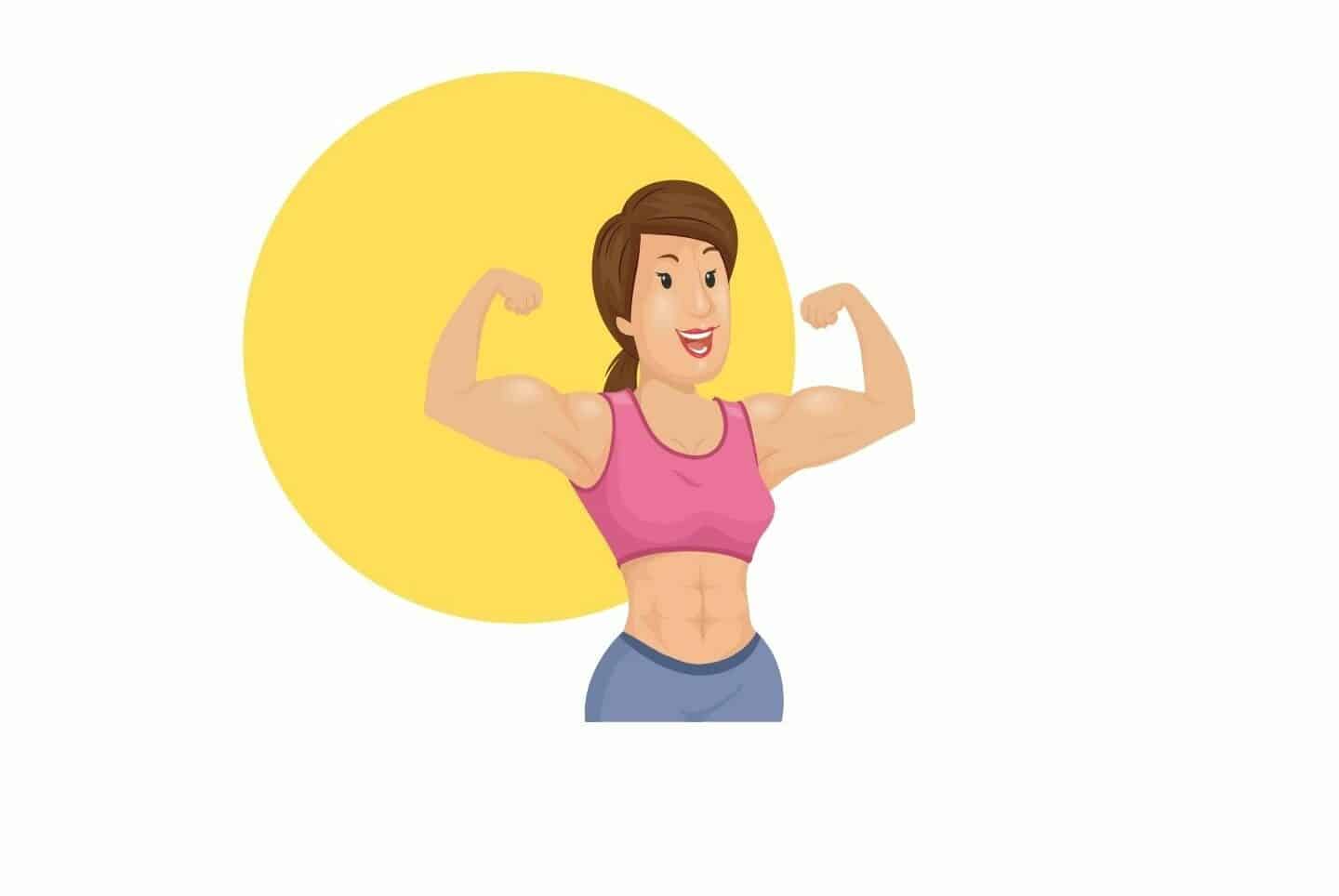
Ahhh the Holy grail of fitness goals.
Who doesn’t want that lean athletic physique seen on magazine covers?!
Weight training will be the best method to reach this goal. It burns fat whilst maintaining muscle mass, resulting in a toned appearance.
Although cardio can be effective at losing weight, excessive cardio without weight training can lead to a skinny undefined look. This is because aerobic cardio will burn through both fat AND muscle.
Losing fat and gaining muscle can also significantly improve your self-esteem and confidence.
Aside from superficial reasons, the muscle-building aspect of weight training also has practical benefits.
Let’s see what these are, shall we?
2. Muscle Is Metabolically Active.
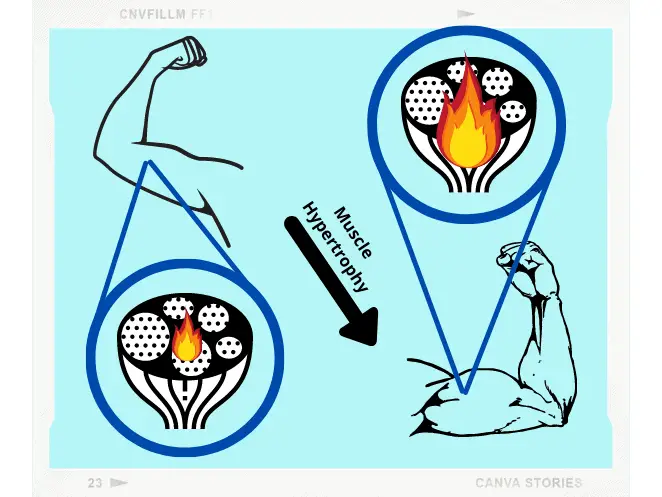
Muscle is metabolically active tissue. This means that it constantly consumes energy, even at rest. (11)
Think of your muscle as a car engine. The bigger the engine, the more power it generates and the more fuel it consumes. And even an idling engine will steadily consume fuel.
In fact, a pound of resting muscle will burn through ~6 calories each day. (9)
This may not sound much, but muscle accounts for ~80% of total body mass in the average healthy adult aged 20-39. (10)
So if you weigh 150 pounds, your resting muscle mass could be consuming a whopping 720 calories per day!
Most people enjoy passive income. But what about passive calorie burning?!
Increasing muscle size (muscle hypertrophy) will facilitate passive calorie expenditure. And weight training is a proven way to induce muscle hypertrophy.
Aside from superficial reasons, the muscle-building aspect of weight training also has practical benefits.
Let’s see what these are, shall we?
3. Better Overall Life Quality.
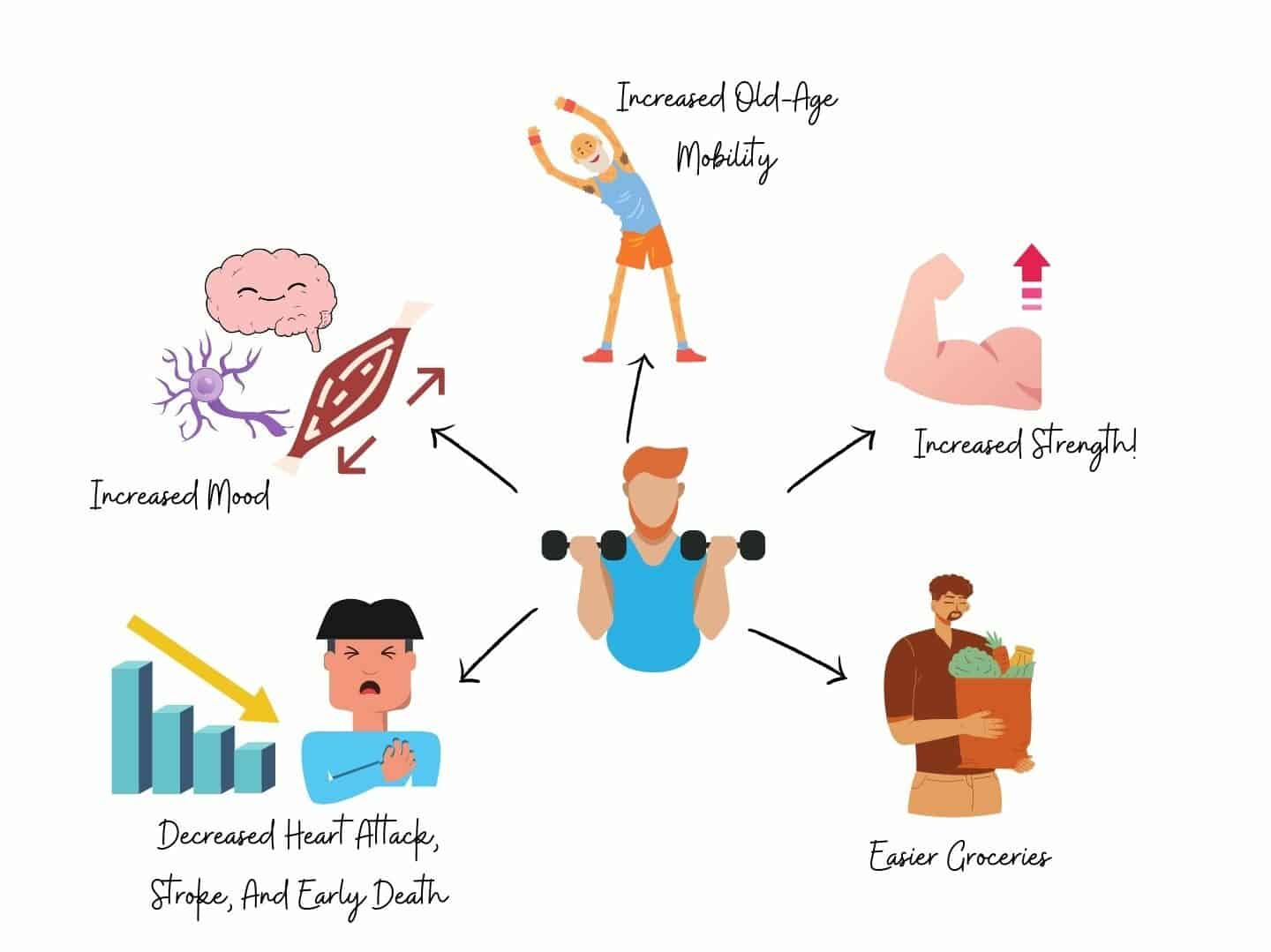
The strength gains associated with regular resistance training will also benefit everyday life.
During a muscle contraction, the brain sends an electrical signal to the neuromuscular junction (the bridge between a neuron and a muscle). This electrical signal causes the muscle to contract
Neurological studies (12) have shown a link between regular weightlifting and increased neuromuscular activation. This maximizes muscular strength, and the results of this study may have future implications for those suffering from strength loss (such as after a stroke or Multiple Sclerosis).
Increased muscle strength is also widely associated with increased mobility in adults. This has important implications for everyone.
As life expectancy increases and our population ages, we should all find ways to mitigate the increasing risk of disability.
Oh, not to mention, increased strength will also make your daily grocery run much easier!
Therefore, investing in a weight training program today will lead to a more fulfilled present and future!
P.S. Weight lifting has also been linked to a 40-70% reduction in heart attack, stroke, and early death. (13)(14)
4. Better Posture, Bone Density.

Do you work a sedentary office job? Do you suffer from bad posture or a fragile frame?
Weightlifting can benefit you!
Habits such as slouching, long periods of inactivity, and poor office furniture cause certain muscles to fatigue or tension to build. This muscle imbalance causes bad posture. (15)
Bad posture not only harms self-esteem, but causes other health complications such as joint pain, neurological damage, and spine curvature (16).
A well-rounded weightlifting programme will correct muscle imbalances. Try concentrating on core and back development!
If you suffer from frequent bone fractures or breakages, weightlifting will also benefit you. Studies have shown that regular weightlifting will slow bone degeneration and stimulate osteoblast (bone cell) development. (17)
More than 8 million people in the USA alone suffer from osteoporosis (18). If you are one of these people, I highly recommend starting a weight training program!
5. Mental Health Benefits.
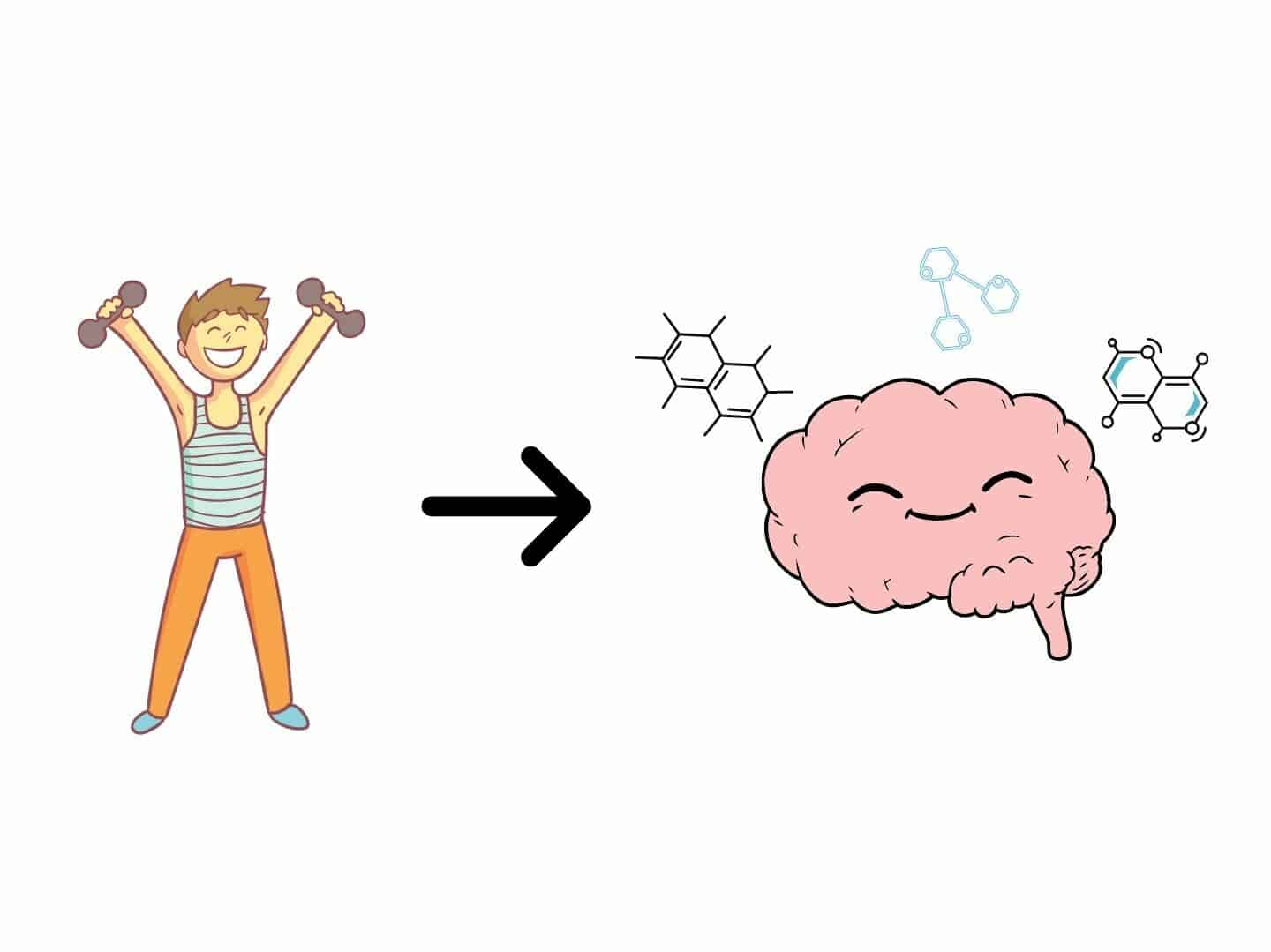
Increased emphasis has been placed on the importance of looking after our mental health. And with good reason.
The stresses of modern living have been detrimental to our mental well-being.
Is your loathsome boss making you’re life miserable? Are your study pressures unbearable?
Weightlifting may give you a completely new outlook on life! It certainly worked for me!
Regular weightlifting (even at low to moderate intensities) has been shown to increase mood and relieve the symptoms of depression, anxiety, and low self-esteem. (20)
Endorphins are responsible for the positive benefits of mood. These are neurochemicals released by the pituitary gland in response to physical stress (like weightlifting!)
Endorphins released in the blood then bind to opioid receptors in the brain. This triggers the analgesic and euphoric effects of the endorphin.
Have you ever heard of the “runners high”? It’s a real physiological phenomenon!
And it happens during vigorous weightlifting too!
6. Fun & Engaging
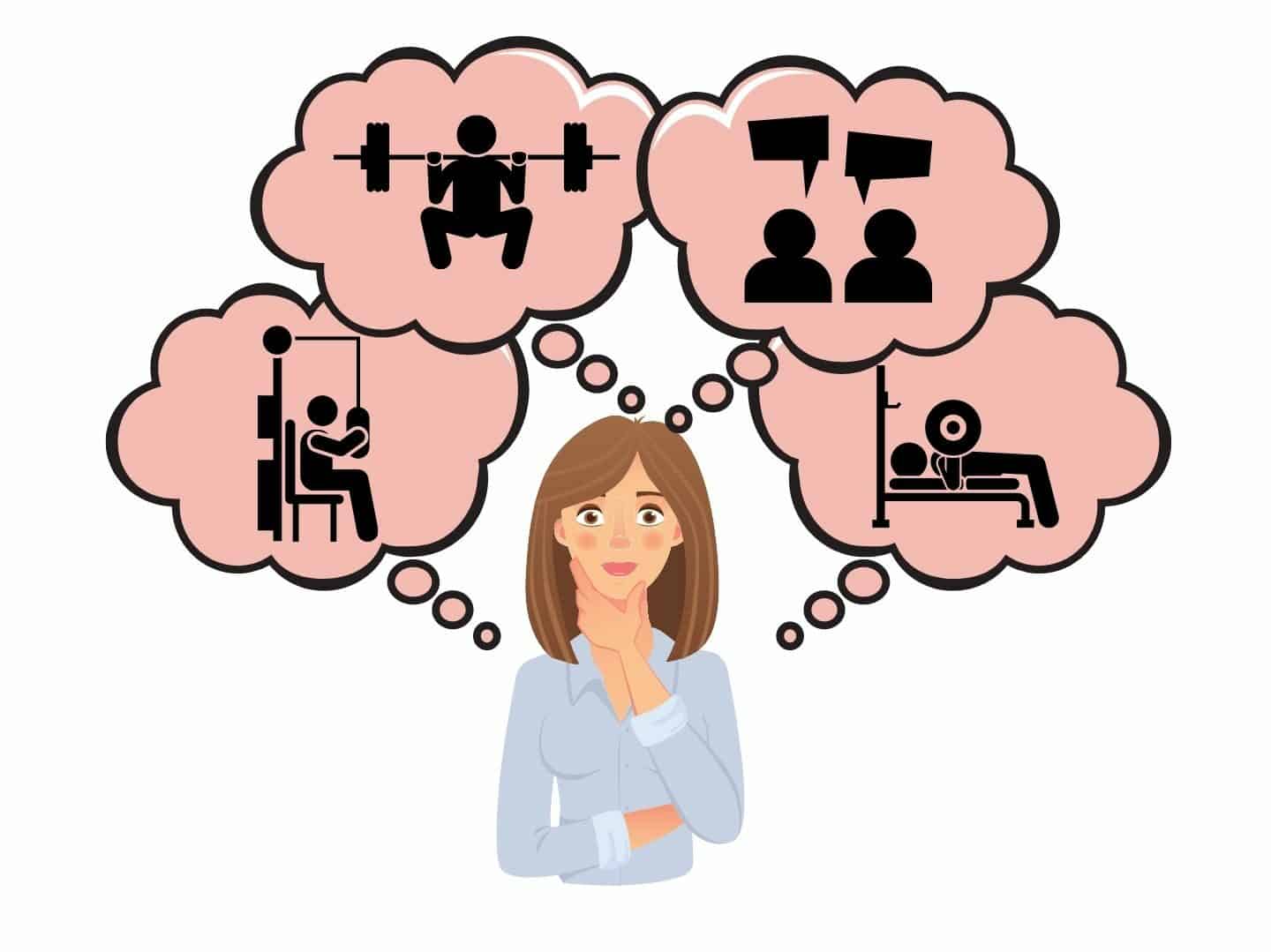
Unlike steady-state cardio, weightlifting can be much more engaging. An effective weight lifting program will contain many different exercises to perform throughout the week.
Each day is a different workout!
Extra variety can also be added by engaging in different training styles. We will explain the different exercises and training styles in more detail later.
You can also work out with friends to make things even more fun. The weightlifting community can also have a very close-knit culture too. You may meet some new friends at the gym!
All this will keep things interesting.
If you are someone who becomes bored easily, try weightlifting.
Nothing beats a good iron pump!
How To Start Weightlifting Today
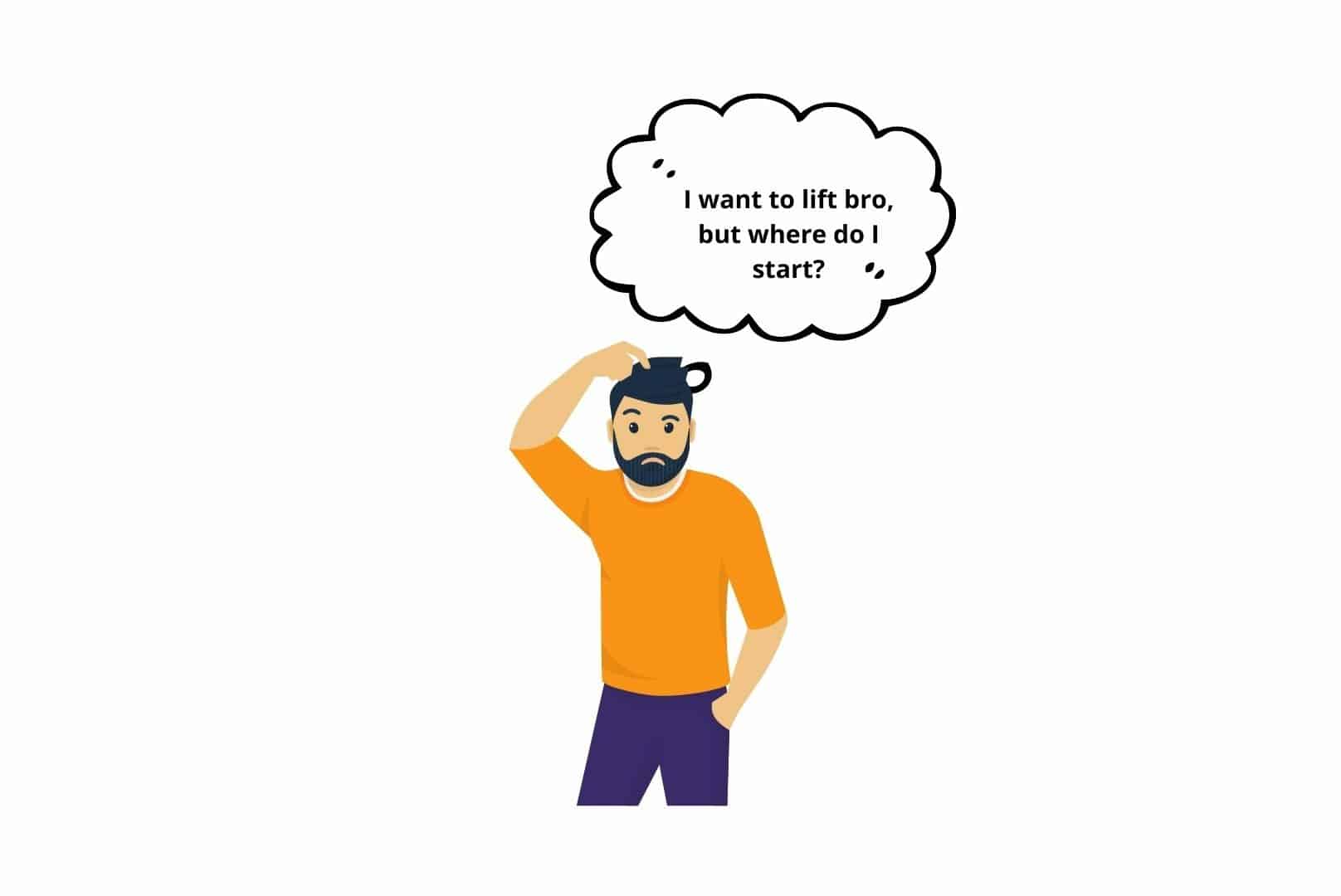
Weightlifting sounds great right?
Hopefully, I have given you enough reasons to start lifting.
But wait.
Now you may be thinking
“I wanna start lifting, but where do I even begin?!”
Fear, not my friend.
We will now describe the different types of weightlifting exercises, equipment, and training styles you will need to create your own weight training programme. You can also check out our guide to lose fat and build muscle.
Let’s take a toilet break and dive right in.
Ready?
Let’s go!
Weight Lifting – Where To Start
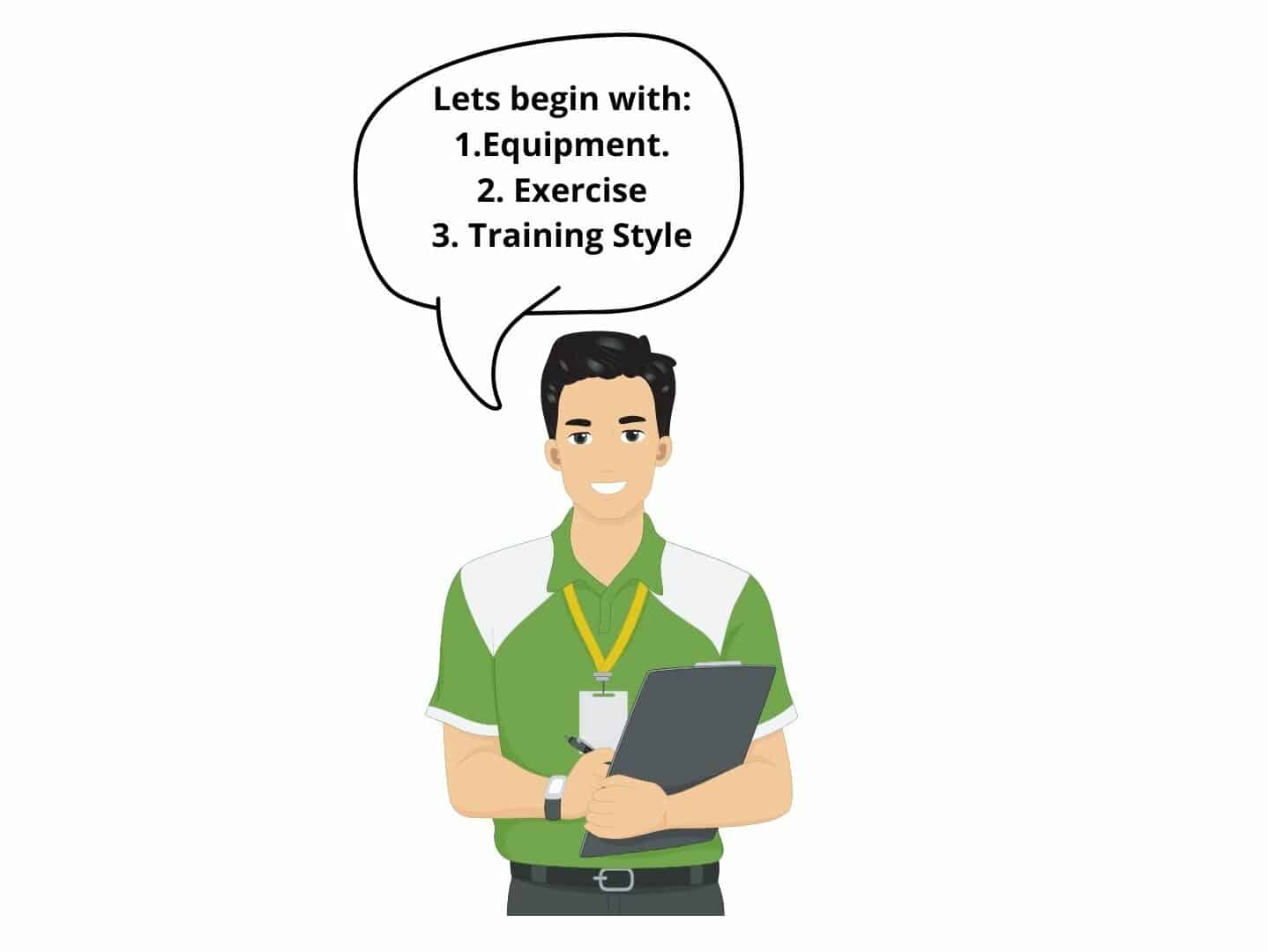
Let’s face it.
The world of weight training can be daunting for a beginner. I still remember when I first started.
There are so many different exercises. Such a large variety of equipment. Everyone seems to be doing different things. Everyone RECOMMENDS different ways to lift.
(Not to mention the intimidating steroid-infused meathead patrolling the gym!)
Where do you even begin?!
3 Basic Components Of Weight Lifting
1) Equipment– the type of equipment used for weight training.
2) Exercise– the exercises performed in a workout.
3) Training style– the weekly method and plan of your programme.
Each of the 3 components has its own variations.
For example, equipment variations include barbells, dumbbells, and weight machines. Exercise variations include bench presses, deadlifts, bicep curls, and many more.
Although it seems like everyone is doing completely different things at the gym, EVERY weightlifting program will vary in these 3 basic components (equipment type, exercise type, and training type).
Different variations are suitable for people with different ability levels and training goals.
Understanding how these 3 basic components will provide the knowledge required to begin weightlifting.
This is what we will explain now.
So keep reading to gain the confidence to create your own weightlifting programme!
1. Equipment Type
First, let’s explain the different types of equipment you can include in a weight training program:
Free Weights
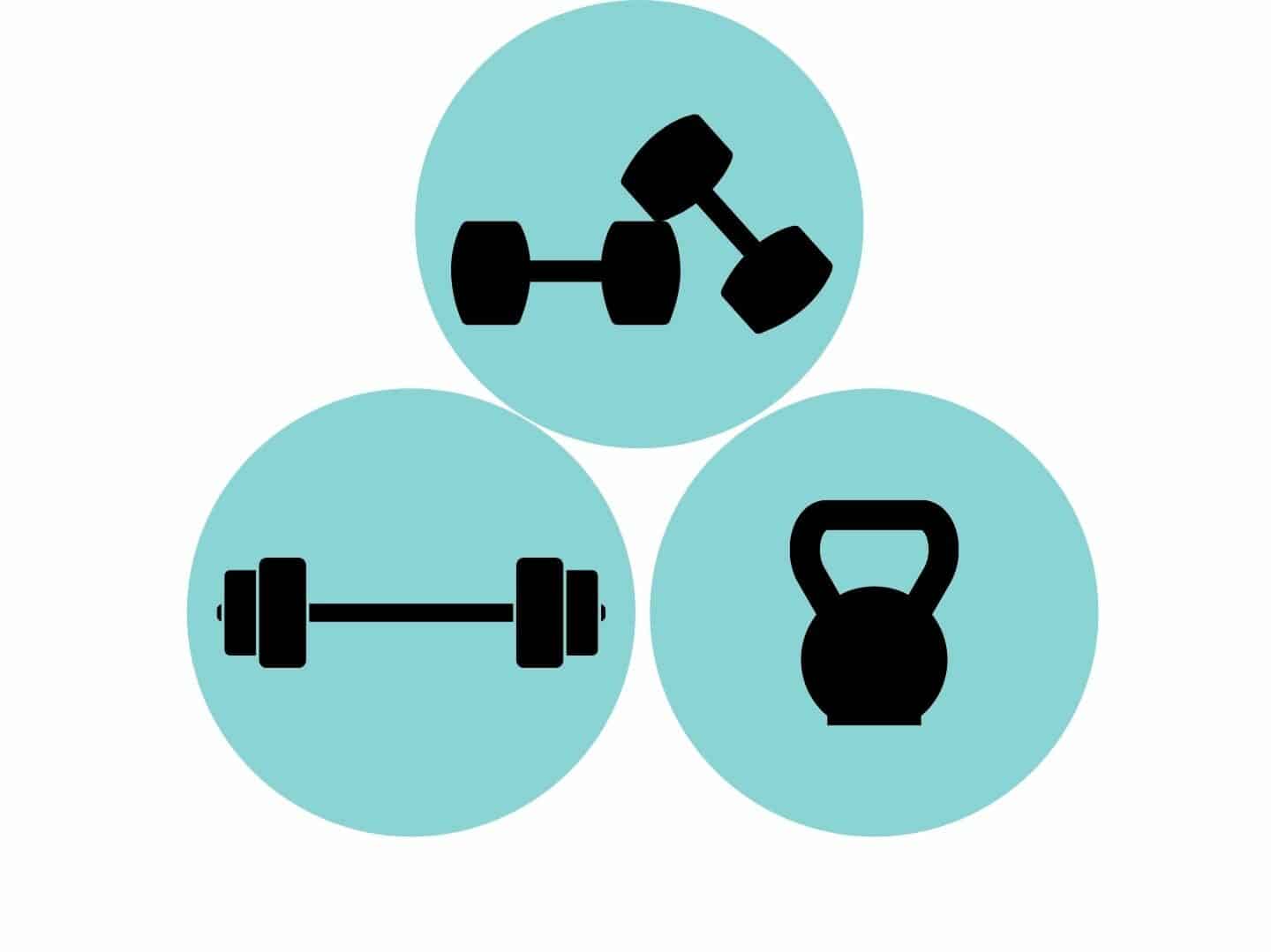
These are the most basic weightlifting equipment (and the most popular!).
They are standalone weights that are not attached to a machine or cable.
Free weights can be used standing or sitting. They are also commonly used with adjustable benches THAT change the angle of an exercise, allowing specific muscle groups to be targeted.
Free weights will provide a great workout, hitting multiple muscle groups, the core, and stabilizer muscles in one motion.
The most commonly used free weights are barbells and dumbbells. Kettlebells are also free weights.
Barbells
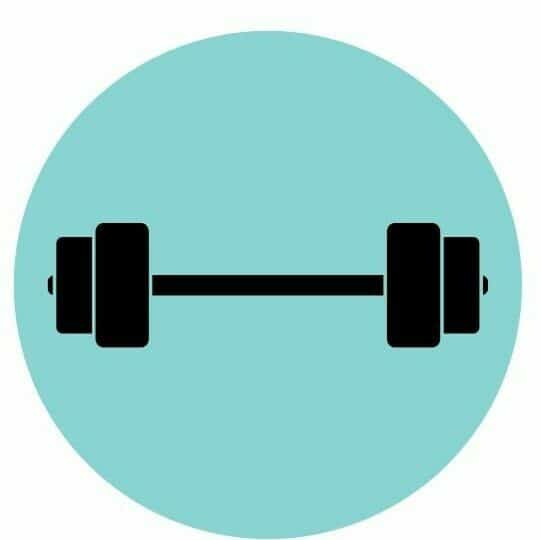
A barbell is an iron bar that measures 4-7 feet long. Different barbell sizes accommodate different weight loads, but they all serve the same purpose.
Weight plates are stacked onto each side of the bar, allowing different weight loads to be lifted. The weight of 7-foot Olympic bar will weigh 20KG alone, so take this into consideration when training!
Barbells can also be fixed-weight. This means the weight is already set and cannot be changed. The weight load is clearly indicated on the barbell.
Due to their size and weight, barbells are usually used for big, all-body lifts (we will explain later).
Barbells are commonly used with racks.
Dumbbells
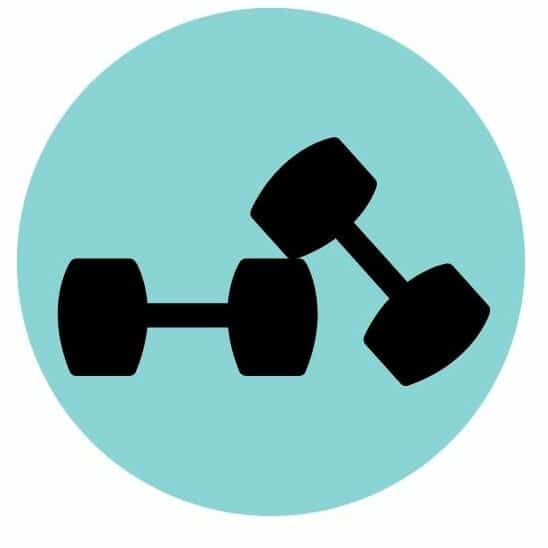
A dumbbell is a much smaller barbell, measuring ~1 foot long. They can be adjustable with weight plates or they can be fixed-weight.
These days, most gyms will only have fixed-weight dumbbells. These are more convenient than their adjustable counterpart.
You will be able to spot them on large dumbbell racks containing weights ranging from 5KG to 60KG+, at 2.5KG increments (i.e. 10KG, 12.5KG, 15KG, and so on).
The small size of dumbbells allows greater maneuverability to target specific muscle groups. They are also great for beginners learning safe techniques.
Weight Machines

A weight machine is a contraption of weight stacks attached to pulleys, cables, and handles. The weight load can be quickly changed by a pin inserted into the weight stack.
Many kinds of weight machines can be found at the gym. Although they all look different, they perform a similar job.
Each machine is used to exercise a specific muscle group. They will often have a label that explains the instructions and muscle groups targeted.
Unlike free weights, machines are guided exercises. This means the machine restricts the direction of movement to one plane.
This makes it great for beginners to safely learn good technique, those recovering from injury, or advanced lifters looking to hit a specific muscle.
Resistance Bands
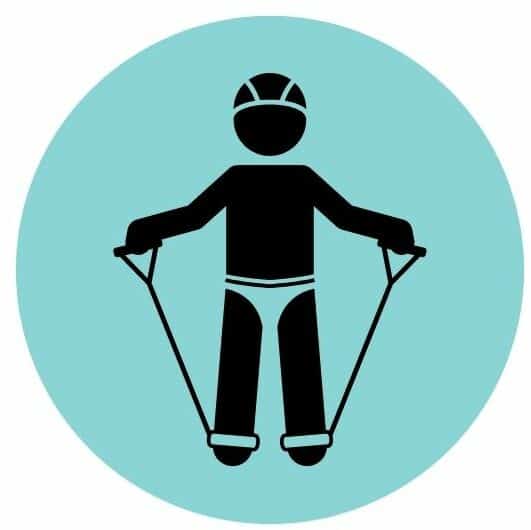
Resistance bands are rubber bands that provide increasing tension as they are stretched. Bands come in different shapes and sizes. Some are literally giant rubber bands. Others have handles and grips.
They also come with different tension levels. A 5kg tension band will be easier to stretch than a 20kg tension band.
Resistance bands aren’t weights in the conventional sense, but they can also provide highly effective resistance.
The practicality of bands makes them ideal for beginners and home workouts. But even advanced lifters will use bands to add variety to their program.
Don’s let the simple-looking nature of bands fool you. They can provide an intense workout when used correctly.
2. Exercise Type
Now, let’s explain the types of exercise you can perform with free weights and weight machines. We will also explain which exercises are the best for fat loss.
Despite the huge variety of exercises you see people performing at the gym, most are all variations of the exercises listed below.
Compound Lifts vs Isolation Lifts
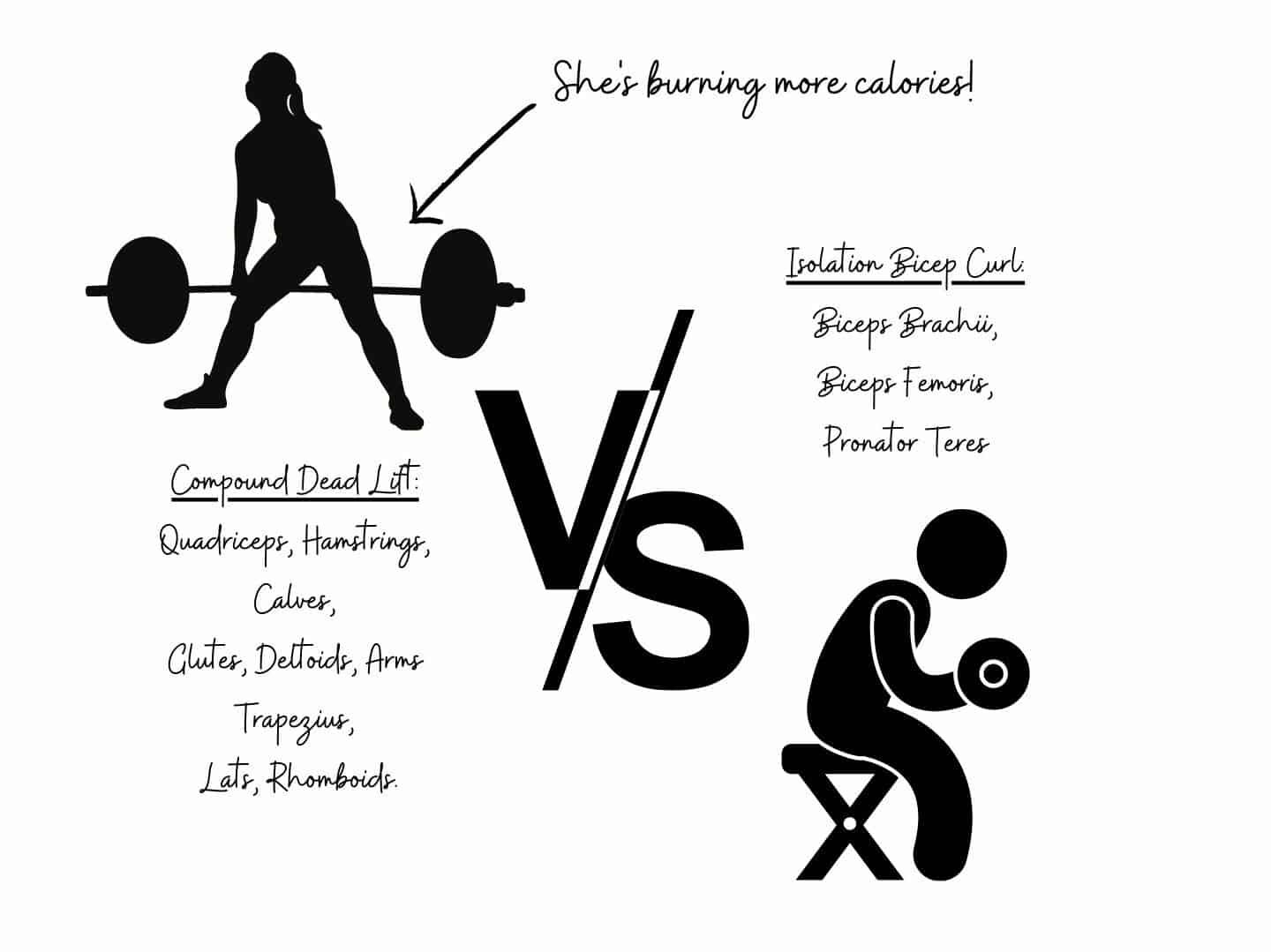
Compound lifts (also called “big or heavy lifts”) are movements that require multiple muscle groups and joints to complete.
Since they activate many muscles, they are excellent at raising the heart rate and burning calories in a short period of time.
Examples: bench presses, squats, lunges, hip raises, deadlifts, overhead presses, rows, pull ups, and more.
Isolation lifts are movements that require only a single muscle group and joint to complete. They are great for developing specific muscles but are relatively ineffective for burning fat (unlike compound exercises)
Examples: bicep curls, leg curls, tricep extension, pec flys, calf raises, abdominal machines, and more.
Learn to identify and choose compound exercises over isolation exercises to burn big calories. (21)
If you are looking to lose fat and develop muscle, lift big!
The 5 Core Lifts
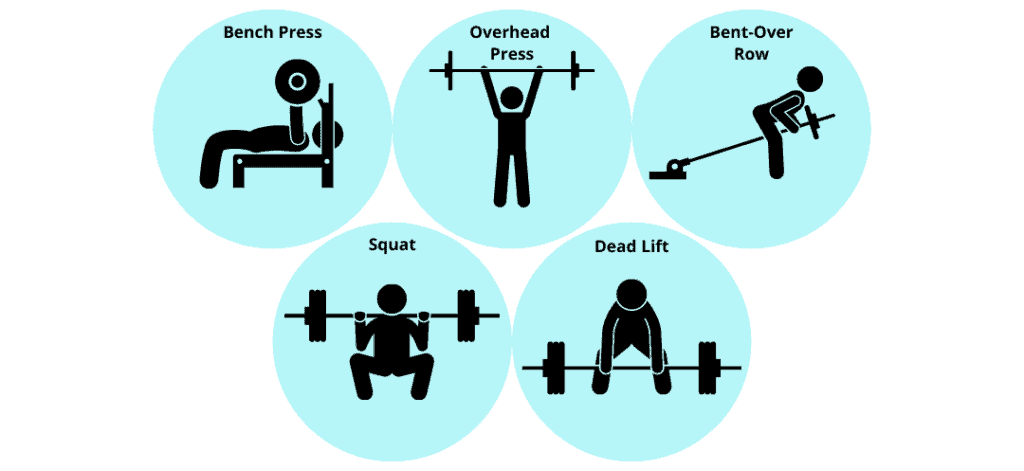
In the weightlifting world, there are 5 specific exercises that you should incorporate into your weight training programme:
These 5 exercises are known as the “5 Core Lifts”.
They are all big compound lifts that activate multiple muscle groups. Combined, they will work the entire body. (21)
By regularly performing the 5 core exercises, you will maximize calories burnt and minimize time spent working out.
You will also stimulate the afterburn effect in the entire body and continue burning calories throughout the day and night. (22)
This makes the core 5 lifts excellent fat-burners and essential additions to your weight training programme.
Check out our amazing guide to burn fat using the 5 core lifts.
These exercises can be performed with barbells, dumbbells, and resistance bands.
If you are an inexperienced lifter, I would recommend practicing safe techniques with light dumbbells before moving onto barbells. This will minimize the risk of injury.
Variations In The 5 Core Lifts
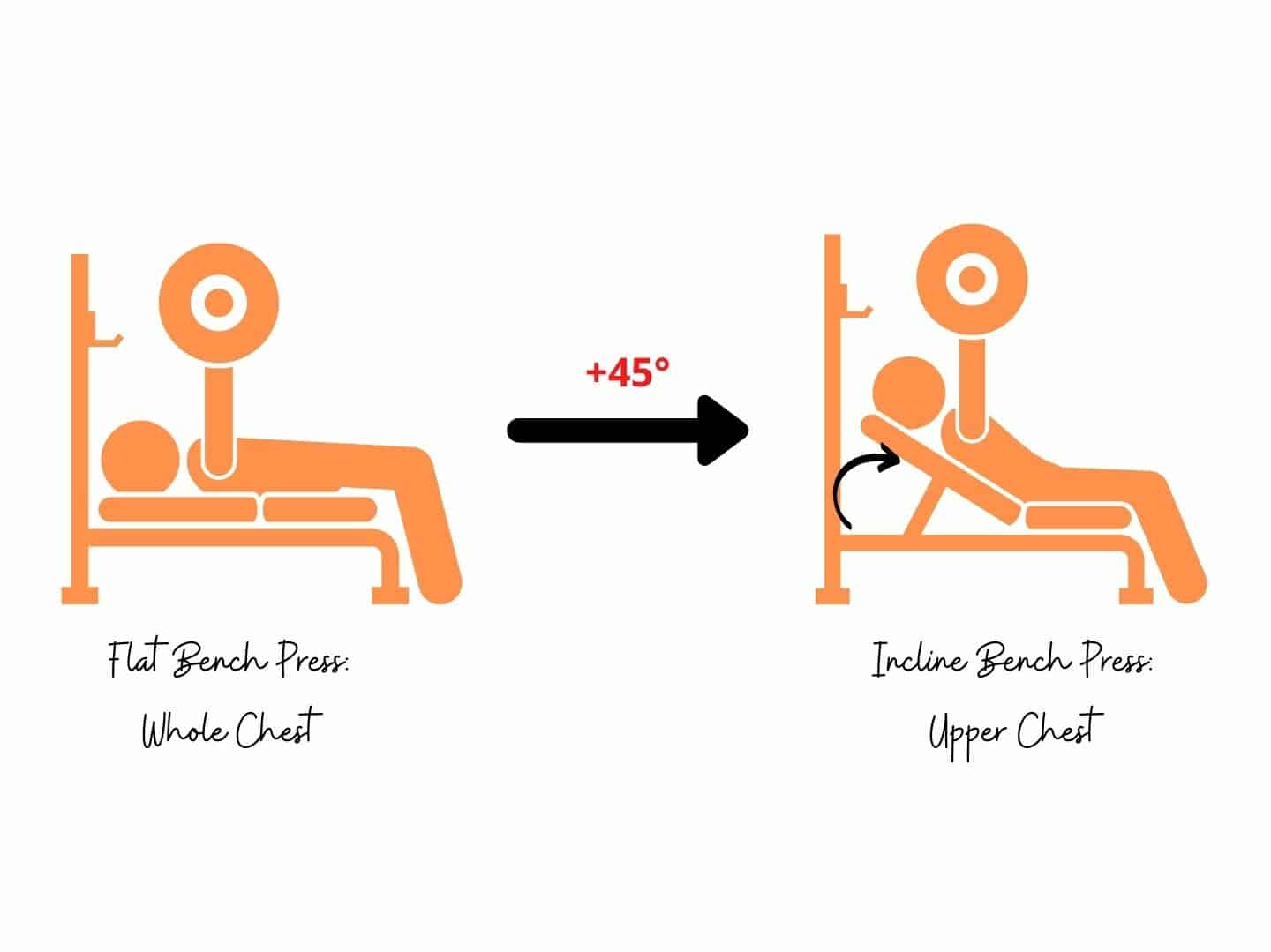
The 5 core lifts can also be supplemented with other compound exercises.
Check out this list of excellent compound exercises to try today. They also provide helpful video tutorials on how to complete each exercise.
You will notice that these exercises look very similar to the 5 core lifts described above.
That’s because they are! The 5 core lifts each have their own variations (or spin-offs)
So why would you bother doing these exercises?
Let me explain.
Why Perform Variation Exercises?
Many weightlifters like to include variations in the 5 core lifts. These variations consist of the same core movements, but with slight changes.
Variations In The Compound Exercises:
1) Angle (Incline vs Decline).
2) Grip Width (Wide vs Narrow).
3) Weight Type (Dumbbell vs Barbell)
Variations are included to focus the workout on different regions of a muscle group. (23)
For example, A normal flat bench press will target the whole chest, but a 45° incline bench press will shift the emphasis on the upper pectoral muscles in the upper chest.
If you are a beginner, whose goal is to shred some fat, the 5 core exercises will be more than enough.
However, this can make your workout program very repetitive.
By adding variation, you will find your program much more engaging!
Spreading your workout between the different regions of a muscle group will also allow you to exercise vigorously for longer. This will maximize afterburn throughout the body.
3. Training Style
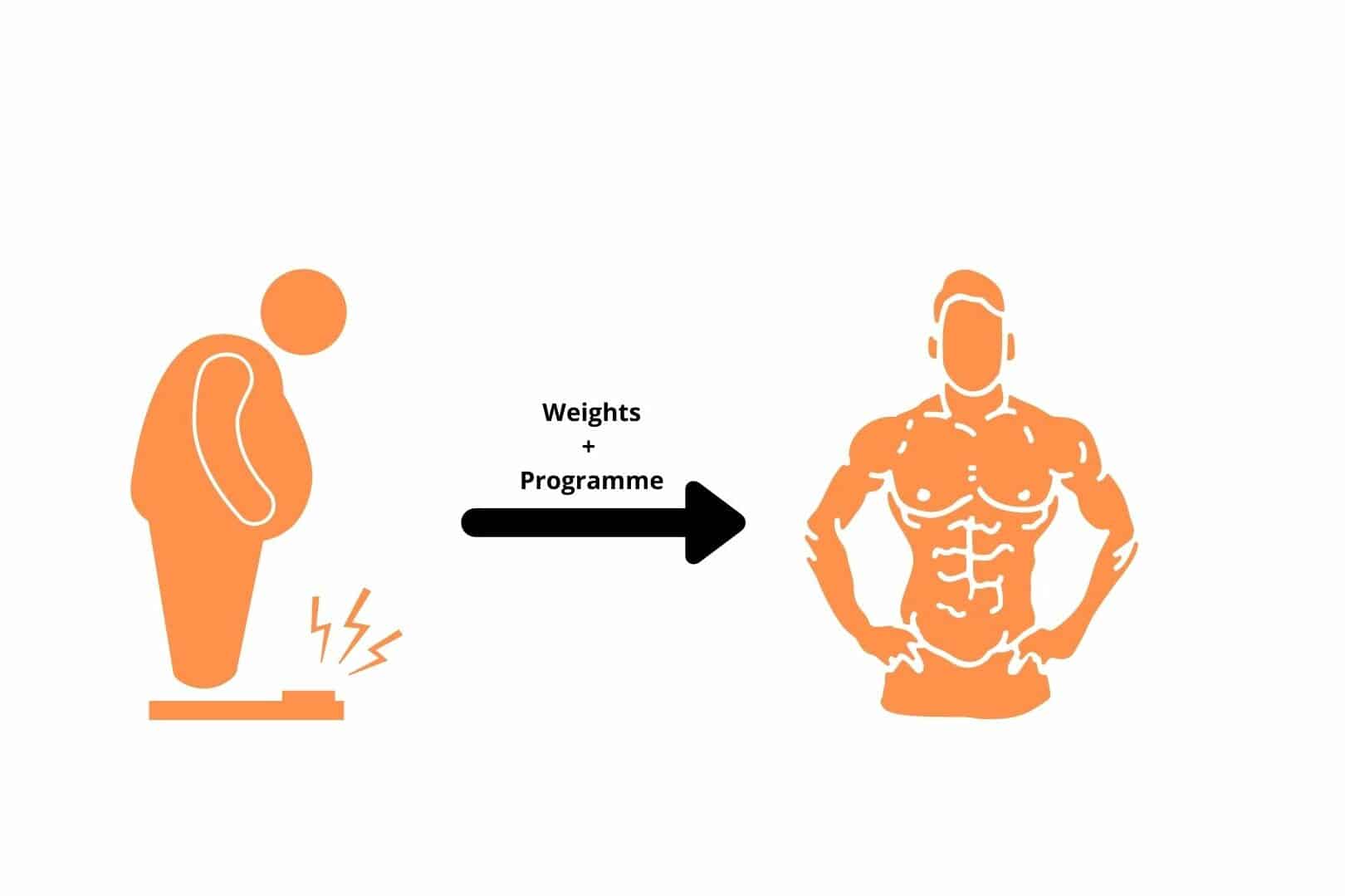
Great, so now we know the different types of equipment and exercise.
We can start lifting right?
Yes.
But weightlifting without a plan is like driving without any coordinates.
Not the best idea!
So now we need a plan. Or a “workout program”.
Parameters To Consider In A Workout Programme:
1) Number of training days
2) Duration of workouts.
3) Style of workout.
Training Days & Duration Of Workout
If you are serious about burning fat, I would recommend training at least 3-5 days a week, 30-60 minutes per workout. This should be combined with a calorie deficit diet.
As with many things in life, the more you put in, the more you get back.
But I would suggest putting a cap on 6 days a week. This will prevent over-exercising, which can lead to burnout and injury. (24)
Training Style
And what about training style? You probably won’t lose pounds just by doing 20 light bench presses a day!).
This is why it’s important to choose a style of lifting.
We will now explain two weight training styles that will help you burn fat:
- Progressive overload training.
- Time under tension training.
Both styles can be combined into the same workout program. Simply alternate between the two styles every week.
Progressive Overload Training
Progressive overload is arguably the most popular training style.
Reps & Sets
It involves doing ~8 repetitions (“reps”) of a specified exercise, resting, and then repeating.
Every 8 reps are called a set. And you should perform 3-6 sets per exercise, with a 1-1.5 minute rest between sets.
Weight load should be at ~70-80% of your maximal lifting capacity (i.e. 70-80% of the maximum weight you can lift).
Determining your Maximal Lifting Capacity
If you have a friend or a personal trainer, maximal capacity would be calculated from a “one rep max”.
This involves lifting as heavy a weight as possible for 1 rep only. The friend would stand by and“spot” you to prevent injury.
This is not recommended for beginners. It can lead to serious injury.
An approximate figure can be obtained through trial and error. This will involve trying different weight loads until you feel you are putting 70-80% effort into lifting the weight.
As a general rule- the muscle should feel fatigued by the end of every set, but still have some energy left to perform one more rep. The muscle should be worked to failure by the last rep of the last set.
You will then proceed to do the same reps and sets throughout the week.
“Overload” Your Weights Each Week
At the start of each new week, increase exercise intensity (try adding an extra 2.5KG or increasing the reps).
Don’t worry if this means you can’t complete the full set. Take a longer rest or go back to the original weight.
This style of training is called progressive overload because you are constantly “overloading” your muscle. So it’s normal to struggle on occasion. Do not let this demoralize you!
Progressive overload will ensure you are maximizing calorie expenditure during training, and afterburn after training!
Time Under Tension Training
Time under tension (TUT) is similar to progressive overload in many ways.
It involves performing reps and sets of each exercise, interspersed with rest periods.
However, the difference is in the weight load and lifting speed.
With progressive overload training, 70-80% of maximal weight capacity is lifted at normal speed, in a smooth controlled motion.
With TUT, you will decrease the weight load to 50% of maximal weight capacity, and also decrease lifting speed.
Each motion should take ~ 5 seconds to complete.
Doing TUT should induce a lactic burn! This is good. You are feeling the effects of afterburn kicking in!
By lifting a lighter weight at a slower pace, calorie expenditure increases. (26)
Conclusion
There we have it!
Today, I have explained why you should lift weights to lose fat and provided a detailed guide on how to lift weights to maximize fat burning.
You should now be able to create your own weightlifting programme with confidence.
Don’t forget- maximal fat loss can only be achieved when combined with an effective diet plan.
So give it a try!
Have you tried afterburn by performing the compound lifts?
Feel free to send me a message if you have any questions! You can find my details on the “contact us” page.
You may also be interested in the downloadable Kalibre Blueprint PDF which details exactly how I gained 40lbs of lean muscle (it’s 100% free!). It details the exact exercises and nutrition (with printable worksheets) I used to go from skinny to ripped!
Thanks for reading guys!
Peace Out,
Kal
(Biochemistry BSc, Biomedical Sciences MSc, Ex-Skinny Guy)

